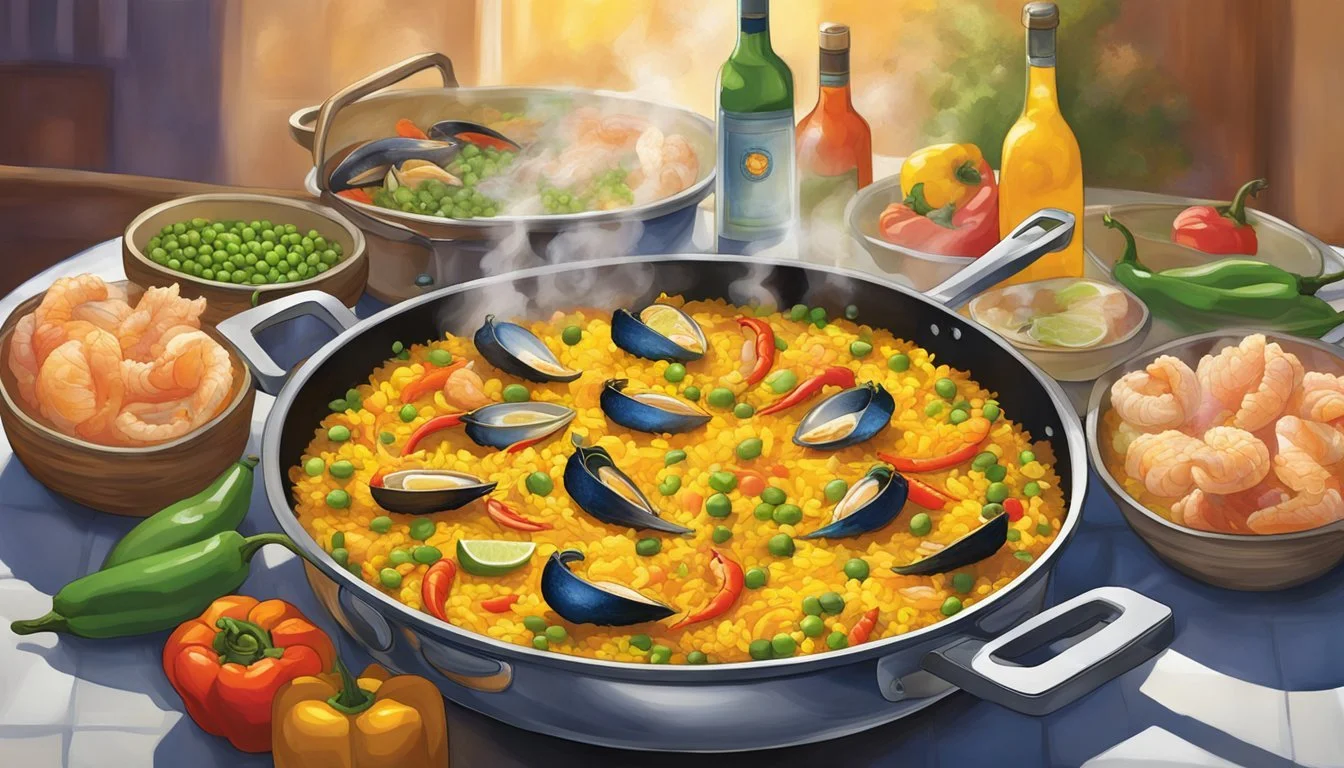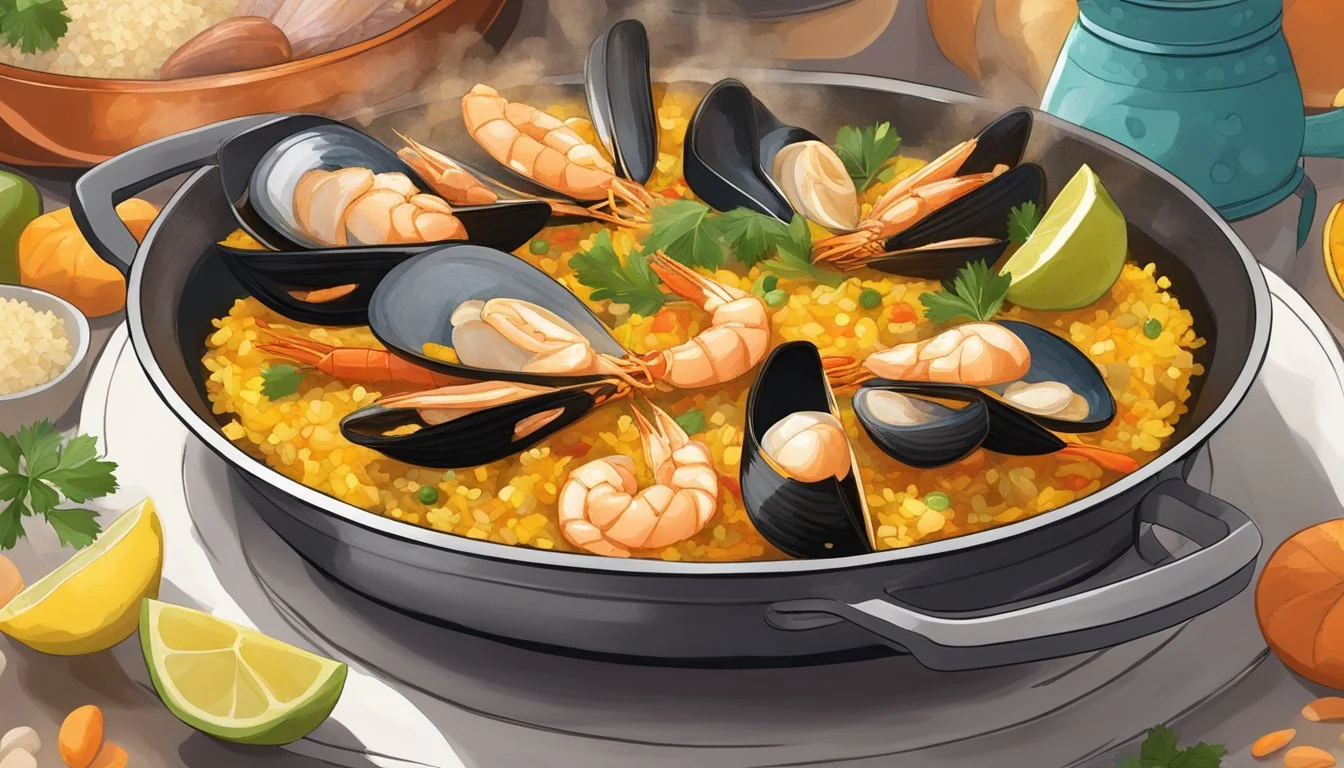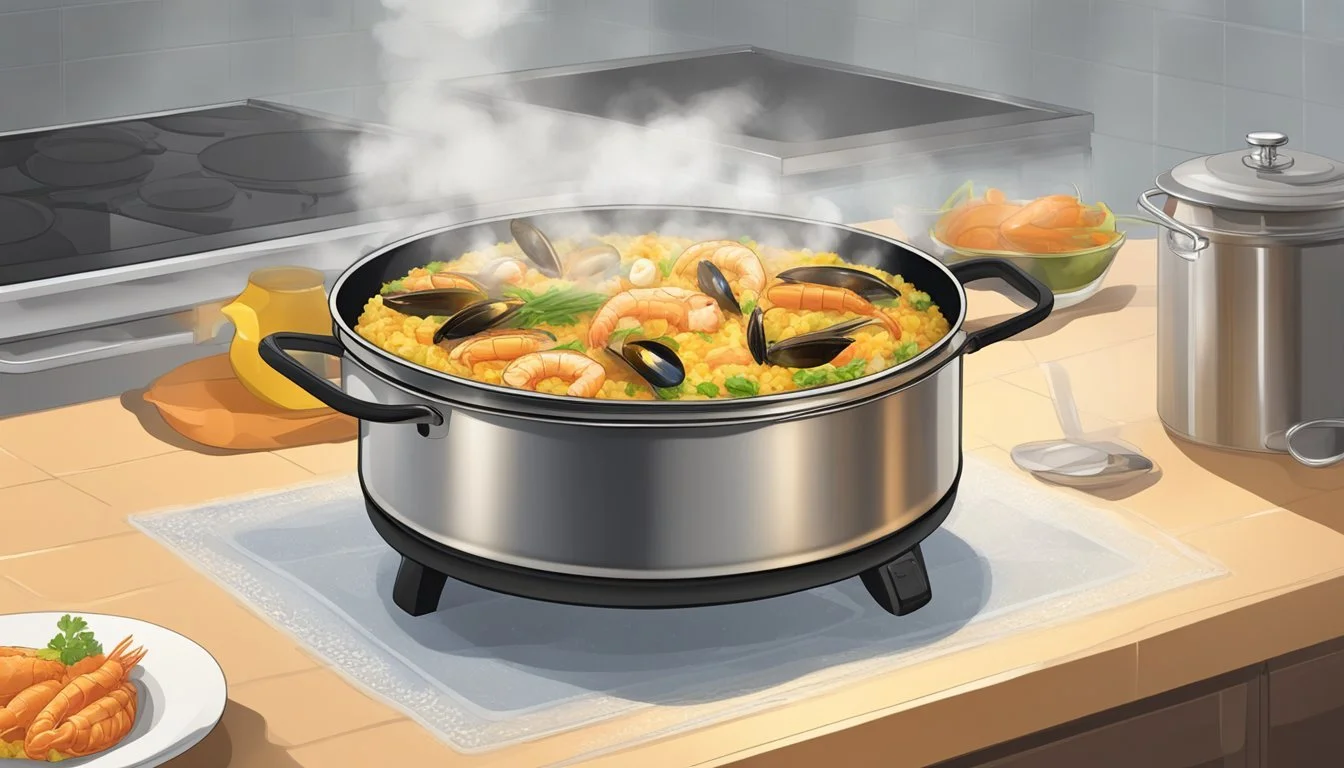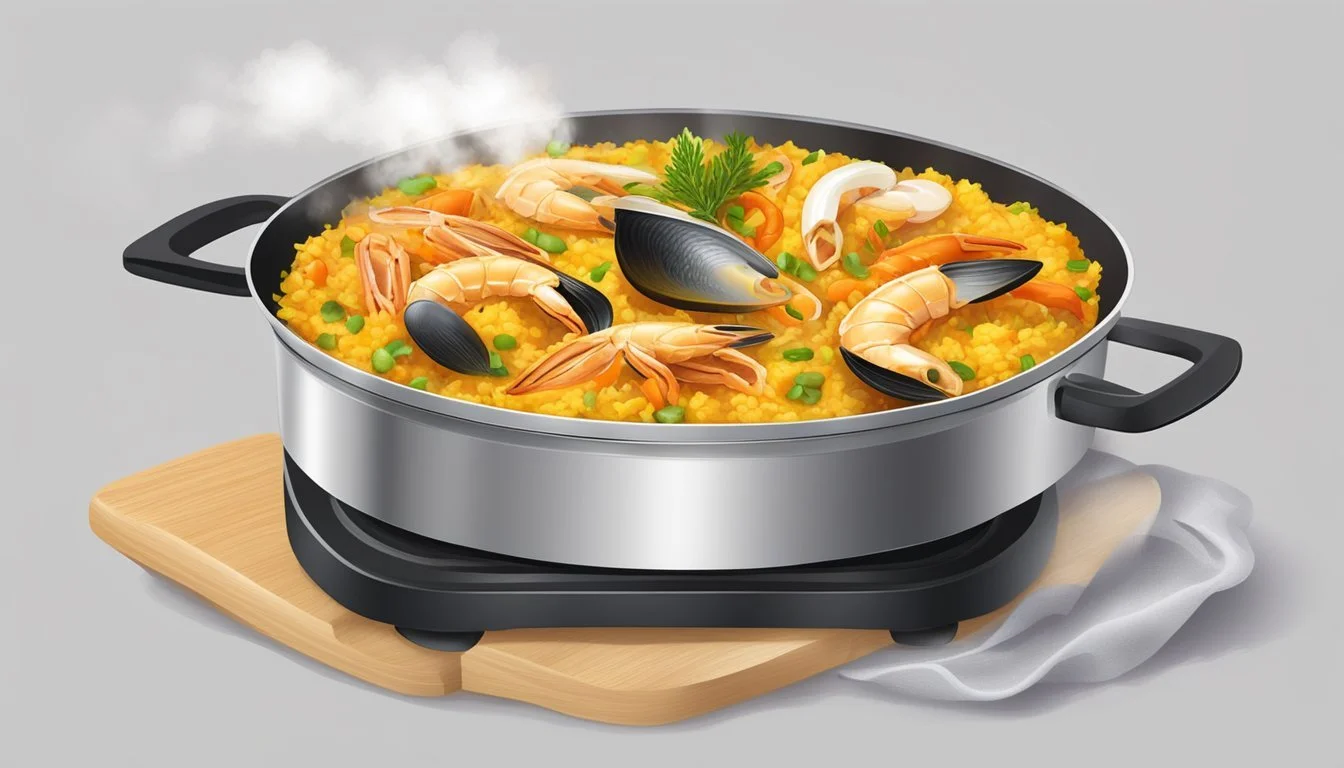Best Way to Reheat Paella
Ensuring Perfectly Fluffy Rice and Succulent Seafood
Paella, a traditional Spanish dish, is renowned for its vibrant flavors and the unique texture of its rice. When perfectly cooked, the rice is fluffy and the seafood tender, offering a delightful culinary experience. However, the complexity of reheating paella lies in maintaining the integrity of its ingredients. The key is to preserve the dish's moisture and avoid overcooking, particularly the delicate seafood (What wine goes well with seafood?) components, to maintain the authentic taste and texture that paella is famous for.
Reheating methods vary, but some are superior in ensuring that the characteristics of paella remain intact. The optimal approach to reheating involves a delicate balance of heat and moisture management. Adding too much water can make the rice soggy, while too little can turn it dry and the seafood rubbery. Thus, the technique selected must gently coax the dish back to its original glory without altering its essential qualities.
Understanding the various elements within paella—the type of rice used, the assortment of seafood, and the even distribution of heat—plays a critical role in choosing the best reheating method. Ensuring the rice stays fluffy and the seafood tender is not only a matter of taste but also a tribute to the authenticity of this celebrated Spanish dish. With proper technique, one can enjoy a reheated paella that retains its original charm and character, making it nearly indistinguishable from its freshly cooked state.
Understanding Paella
Paella is a hallmark of Spanish cuisine, renowned for its robust flavors and a harmonious blend of rice, proteins, and spices. The dish demands precision in both ingredients and preparation to achieve its characteristic texture and taste.
Key Ingredients
Paella boasts a wide range of fresh ingredients, each playing a pivotal role in the dish’s overall flavor profile. Central to the dish is short-grain rice, commonly bomba or Calasparra, known for its ability to absorb flavors without becoming mushy. Proteins often include a combination of chicken, rabbit, seafood (like shrimp and mussels), (What wine goes well with mussels?) and sometimes chorizo for a hearty touch. Integral to the dish's color and aroma is saffron, along with paprika and garlic. Tomatoes and a variety of beans add to the medley of tastes paella is famous for.
Traditional Cooking Methods
Traditionally, paella is cooked in a wide, shallow pan called a paellera. The method begins with browning proteins then sautéing the essential aromatic ingredients like garlic and paprika. Rice is then added and toasted briefly, followed by a carefully measured amount of stock which is absorbed slowly as the rice cooks. The pan is usually left uncovered, and the heat not stirred to allow for the development of a socarrat - a coveted crispy layer at the bottom.
Importance of Texture and Flavor
Paella's allure lies in its distinct texture and deep flavors. The rice should be fluffy and al dente, each grain separate from the other, while the proteins like the seafood need to be tender, not rubbery. The dish should be moist but not soggy, with the flavor of saffron and the smokiness of paprika permeating through every bite. It's a delicate balance that requires not just the right ingredients but the right technique.
Storing Paella
Proper storage is crucial for maintaining the quality and safety of leftover paella. An airtight container is essential to preserve freshness, whether storing paella in the refrigerator or freezer.
Refrigeration Tips
When refrigerating leftover paella, it should be promptly placed in an airtight container to prevent it from drying out and to keep odors at bay. The refrigerator temperature should be set below 40°F to avoid the risk of food poisoning. Leftover paella typically has a shelf life of 2-3 days when refrigerated.
Promptness: Transfer paella to the refrigerator within two hours of cooking to prevent bacterial growth.
Temperature: Keep the refrigerator set below 40°F.
Airtight Container: Seal paella in a container with a tight-fitting lid.
Shelf Life: Consume refrigerated paella within 2-3 days for best quality.
Freezing and Thawing Procedures
Freezing leftover paella extends its shelf life to approximately 1-2 months. For optimal results, one should use freezer-safe airtight containers or heavy-duty freezer bags. Thawing should be done in the refrigerator overnight to ensure safety and to maintain quality.
Portions: Divide paella into individual servings for easier thawing and reheating.
Containers: Use freezer-safe containers or bags to protect against freezer burn.
Freezing: Cool paella completely before freezing.
Thawing: Thaw in the refrigerator to minimize the risk of foodborne illnesses.
Preparing to Reheat Paella
Proper preparation ensures that reheated paella maintains the quality of its initially served state. The process starts with defrosting if the leftovers are frozen, followed by techniques that promote even heating to keep the rice fluffy and the seafood tender.
Defrosting Overnight
If the paella is frozen, it should be transferred from the freezer to the refrigerator to defrost overnight. This gradual thawing helps maintain the texture of the rice and integrity of the seafood. It also prevents the growth of bacteria that could occur with rapid temperature changes.
Ensuring Even Heating
Before reheating, separate any large clumps of rice to enable even heating. For the best results, the paella should be spread evenly in the chosen reheating dish or pan. Seafood and other delicate toppings need careful handling to avoid overcooking during the reheating process.
Reheating Methods
Choosing the right reheating method for paella is crucial to maintaining the dish's quality. Whether using the oven, stovetop, or microwave, the key is to preserve the paella's moisture while ensuring it is heated thoroughly to avoid foodborne illness.
Oven Reheating
Pros: Keeps texture consistent and prevents seafood from drying out
Cons: Takes longer than other methods
Preheat the oven to 350℉ (175℃).
Place paella in an oven-safe dish, add a half cup of water.
Cover the dish with foil to trap steam.
Bake for 20-25 minutes, checking moisture regularly.
Stovetop Reheating
Pros: Offers more control over temperature
Cons: Requires constant attention
Use a heavy-bottomed pan and add 2-3 tablespoons of stock or water.
Add paella; stir gently to distribute moisture.
Cover with a lid to retain steam and heat.
Heat on medium for 4-5 minutes, stir occasionally.
Microwave Reheating
Pros: Fastest method
Cons: Can make rice gummy if not careful
Place paella in a microwave-safe container.
Drizzle with a little oil or add a splash of water.
Cover with a microwave-safe lid or plastic wrap.
Microwave on high for 1 minute, then stir and check heat distribution. Repeat if necessary.
Preserving Quality While Reheating
Reheating paella requires careful attention to both the rice and seafood components to maintain the dish's distinctive texture and flavors. The ideal outcome preserves the fluffiness of the rice while ensuring that the seafood remains tender.
Maintaining Fluffy Rice
Rice is the core ingredient in paella, and its consistency post-reheating profoundly affects the dish. To keep the rice fluffy:
Moisture: Add a small amount of liquid (water, stock, or broth) to the paella before reheating. Typically, 2-3 tablespoons suffice to restore moisture without making the rice soggy.
Heat Distribution: Spread the paella evenly in the pan or dish to ensure uniform heat distribution.
Covering: Use a lid or cover with foil to trap the steam, aiding in the even reheating of the rice.
Keeping Seafood Tender
Seafood in paella can become tough if overheated. To preserve its tenderness:
Low Temperature: Reheat at a medium-low temperature to prevent the seafood from becoming rubbery.
Olive Oil: A thin layer of olive oil can protect the delicate texture of the seafood and add richness.
Duration: Limit reheating time. Seafood requires less time than rice, so consider adding seafood later in the reheating process if possible.
Adding lemon wedges when serving can enhance the flavors and add a fresh zest, complementing the reheated dish without overpowering the original seasonings.
Safely Reheating Paella
When reheating paella, maintaining the quality of the rice and seafood is as important as ensuring food safety. Temperature control and preventing bacterial growth are fundamental to achieving this.
Temperature Considerations
To prevent food from becoming a breeding ground for bacteria, one should always reheat paella to an internal temperature of 165°F. Using a food thermometer can confirm that it has reached this safe temperature. It's crucial to heat the paella evenly, so stirring occasionally is recommended if using a stovetop, or pausing to stir if using a microwave.
Avoiding Bacterial Growth
Paella should be refrigerated within two hours of cooking to inhibit bacterial growth. When reheating, it's advisable to only warm the amount that will be consumed, as multiple rounds of reheating can increase the risk of food poisoning. One should make sure the paella is stored in a sealed container in the fridge to keep it safe for consumption.
Enhancing Reheated Paella
Reheating paella should not only aim to warm up the dish but also to revitalize its vibrant flavors and freshness. By incorporating fresh ingredients and artful serving suggestions, one can elevate the reheated paella to closely resemble its freshly made glory.
Adding Fresh Ingredients
To enhance the flavor of reheated paella, adding fresh ingredients is key. It is advisable to:
Season: Adjust seasoning with a pinch of salt or a dash of smoked paprika to bring back the dish's robust essence.
Vegetables: Sauté additional vegetables, such as bell peppers or peas, and mix them in to restore vibrancy.
Proteins: Freshly cooked seafood or meat can be added on top to complement existing ingredients.
Lemon: A squeeze of fresh lemon juice over the paella can brighten up flavors and add a zesty note.
Serving Suggestions
Presentation and serving enhancements can make a significant difference in the enjoyment of reheated paella:
Garnishes: Boldly sprinkle finely chopped parsley or slices of lemon for fresh color and a dynamic taste.
Valencia Touch: Emulate the traditional paella from Valencia by incorporating classic garnishes like rosemary sprigs or artichoke hearts.
Plating: Serve in a wide, shallow dish to allow even heat distribution and exhibit the array of ingredients, making it visually appealing.
Alternative Uses for Leftover Paella
Leftover paella can be a versatile ingredient in the kitchen. It offers an opportunity to be resourceful and creative with its combination of fluffy rice, vegetables, and meat or seafood.
Creative Recipe Ideas
Paella Stuffed Peppers: One can hollow out bell peppers and fill them with leftover paella, top with shredded cheese, and bake until the peppers are soft and the cheese is melted.
Paella Frittata: Beat together eggs and pour over the paella in a skillet, cooking until the eggs are set for a Spanish twist on the Italian classic.
Paella Cakes: Mix the leftover paella with an egg and breadcrumbs, form into patties, and pan-fry until golden brown, offering a tempting crunchy texture.
Paella Soup: Leftover paella can serve as a base for a hearty soup by adding it to a pot with broth, additional vegetables, and herbs, simmering to let the flavors meld together.
Utilizing leftover paella in innovative ways not only minimizes food waste but also enriches the dining experience with new flavors and textures inspired by the original dish.
Conclusion
When it comes to reheating paella, the key objective is to maintain the dish’s robust flavor and the ideal texture of the rice and seafood. For those who stored paella in the fridge, using specific techniques can make a significant difference in the quality of the reheated paella.
Oven Method: A moderate oven temperature of 350℉ for 20-25 minutes with a half cup of water can revive paella, keeping the rice fluffy and preventing dryness.
Stovetop Method: A heavy-bottomed pan with a little liquid (stock or water) over medium heat can keep the flavors concentrated and the rice from becoming soggy. Heating for 4-5 minutes should suffice.
Microwave Method: A quick method for small portions — add a touch of oil and cover with a microwave-safe lid for an even distribution of heat, usually in one-minute intervals.
It is paramount to avoid scorching the rice or overcooking the seafood, as both can significantly affect the flavor profile and texture of the reheated paella. Adding a bit of stock can replenish moisture and enrich the dish without sacrificing the seafood’s tenderness.
Employing these methods can help one achieve nearly the same quality as when the paella was first prepared. For the best experience, it is advisable to consume the reheated paella promptly after warming to enjoy its maximum flavor and freshness.







